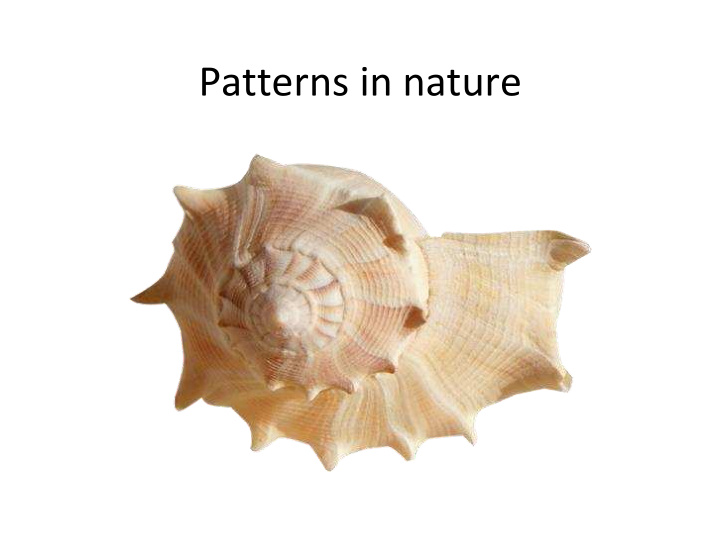



Patterns in nature
Patterns associated with function
Not exactly the same Signal Peptide
Functional Characterization of Proteins ● classify proteins into families ● predicting domains and important sites ● predictive models, (signatures) ● several different databases that are members of the InterPro consortium. http://www.ebi.ac.uk/interpro/
Domains Motifs Protein DNA and Protein a conserved part of a protein a nucleotide or amino- sequence and structure that acid sequence pattern can evolve, function, and exist that is widespread and independently of the rest of can have a biological the protein chain. significance. ● Binding sites ● Enzyme activity ● Regulatory regions
Domains at VEuPathDB As we integrate data, we run programs that match or predict domains. We display this information on gene pages and create genome-wide searches of the program results InterProScan - matches proteins against the InterPro protein signature databases Signal P - predicts Signal Peptides in proteins TMMHMM - predicts Transmembrane domains in proteins
How do we search for a motif in the VEuPathDB sea of DNA and protein? Motif searches (text strings) Genome Proteome Motif Location
Regular expression is like another language • a sequence of symbols and characters expressing a string or pattern to be searched for within a longer piece of text. • Build in the ambiguity of a consensus sequence. • Normal characters and symbols – Alphanumeric abc …ABC…0123... – Symbols punctuation to account for ambiguity -_ ,.;:=()/+ *%&{}[]?!$’^| \<>"@# • Just like languages Regular expressions also have dialects – awk, egrep, Emacs, grep, Perl, POSIX, Tcl, PROSITE
Why use a regular expression? To find a pattern MALDVANRPMPKPEMFAAHRAKTLAELRKRKLEGVVLIYGFP EPTRAHCDFEPVFRQESCFYWLTGVNEADCAYFLDIETGKEILF YPDIPQAYIIWFGELATIDDIQQQQQGFEDVRLMPKIQETLAE YKLKKIHTLPETCILKGYVAVKDKNEFIDVVGELRQIKDDDEMV LIQYACDVNSFAVRDTFKKVHPKMWEHQVEANLIKHYVDYYC RCFAFSTIVCSGENCSILHYHHNNKFIEDGELILIDTGCEYNCAA DNTRTIPANGKFSPQQQQQRAVYQAVVAVKLDCHNYVVAH AKPGVWPDLAYDSAKVMAAGLLKLGLFQNGTVDEIVDAGAL AVFYPHGLGHGMGIDCHEIAHRAKGWPRGTCRGKKPHHSFV RFGRTLEKGVVITNEPGCYFIRPSYNAAFADPEKSKYINKEVCER LRKTVGGVRIEDDLLITEDGCKVLSNIPKEIHRAKDEIEAFMAKK ESKL
Why use a regular expression? To find a pattern MALDVANRPMPKPEMFAAHRAKTLAELRKRKLEGVVLIYGFP EPTRDRINKFEPVFRQESCFYWLTGVNEADCAYFLDIETGKEILF YPDIPQAYIIWFGELATIDDI QQQQQ GFEDVRLMPKIQETLAE YKLKKIHTLPETCILKGYVAVKDKNEFIDVVGELRQIKDDDEMV LIQYACDVNSFAVRDTFKKVHPKMWEHQVMILKHYVDYYCR CFAFSTIVCSGENCSILHYHHNNKFIEDGELILIDTGCEYNCAAD NTRTIPANGKFSP QQQQQ RAVYQAVVAVKLDCHNYVVAHAK PGVWPDLAYDSAKVMAAGLLKLGLFQNGTVDEIVDAGALAV FYPHGLGHGMGIDCHEIAHRAKGWPRGTCRGKKPHHSFVRF GRTLEKGVVITNEPGCYFIRPSYNAAFADPEKSKYINKEVCERLR KTVGGVRIEDDLLITEDGCKVLSNIPKEIHRAKDEIEAFMAKKES KL
Why use a regular expression? To find a pattern MALDVANRPMPKPEMFAAHRAKTLAEL RKRK LEGVVLIYGFP EPTRDRINKEPVFRQESCFYWLTGVNEADCAYFLDIETGKEILF YPDIPQAYIIWFGELATIDDI QQQQQ GFEDVRLMPKIQETLAE YKLKKIHTL RKRK ILKGYVAVKDKNEFIDVVGELRQIKDDDEMV LIQYACDVNSFAVRDTFKKVHPKMWEHQVMILKHYVDYYCR CFAFSTIVCSGENCSILHYHHNNKFIEDGELILIDTGCEYNCAAD NTRTIPANGKFSP QQQQQ RAVYQAVVAVKLDCHNYVVAHAK PGVWPDLAYDSAKVMAAGLLKLGLFQNGTVDEIVDAGALAV FYPHGLGHGMGIDCHEIAHRAKGWPRGTCRGKKPHHSFVRF GRTLEKGVVITNEPGCYFIRPSYNAAFADPEKSKY RKRK VCERL RKTVGGVRIEDDLLITEDGCKVLSNIPKEIHRAKDEIEAFMAKKE SKL
Why use a regular expression? To find a pattern MALDVANRPMPKPEMFAAHRAKTLAEL RKRK LEGVVLIYGFP EPTR DRINK EPVFRQESCFYWLTGVNEADCAYFLDIETGKEILF YPDIPQAYIIWFGELATIDDI QQQQQ GFEDVRLMPKIQETLAE YKLKKIHTL RKRK ILKGYVAVKDKNEFIDVVGELRQIKDDDEMV LIQYACDVNSFAVRDTFKKVHPKMWEHQV MILK HYVDYYCR CFAFSTIVCSGENCSILHYHHNNKFIEDGELILIDTGCEYNCAAD NTRTIPANGKFSP QQQQQ RAVYQAVVAVKLDCHNYVVAHAK PGVWPDLAYDSAKVMAAGLLKLGLFQNGTVDEIVDAGALAV FYPHGLGHGMGIDCHEIAHRAKGWPRGTCRGKKPHHSFVRF GRTLEKGVVITNEPGCYFIRPSYNAAFADPEKSKY RKRK VCERL RKTVGGVRIEDDLLITEDGCKVLSNIPKEIHRAKDEIEAFMAKKE SKL
VAVK
Why use a regular expression? To find a pattern MALDVANRPMPKPEMFAAHRAKTLAELRKRKLEGVVLIYGFP EPTRDRINKEPVFRQESCFYWLTGVNEADCAYFLDIETGKEILF YPDIPQAYIIWFGELATIDDIQQQQQGFEDVRLMPKIQETLAE YKLKKIHTLRKRKILKGY VAVK DKNEFIDVVGELRQIKDDDEMV LIQYACDVNSFAVRDTFKKVHPKMWEHQVMILKHYVDYYCR CFAFSTIVCSGENCSILHYHHNNKFIEDGELILIDTGCEYNCAAD NTRTIPANGKFSPQQQQQRAVYQAV VAVK LDCHNYVVAHA KPGVWPDLAYDSAKVMAAGLLKLGLFQNGTVDEIVDAGALA VFYPHGLGHGMGIDCHEIAHRAKGWPRGTCRGKKPHHSFVR FGRTLEKGVVITNEPGCYFIRPSYNAAFADPEKSKYRKRKVCER LRKTVGGVRIEDDLLITEDGCKVLSNIPKEIHRAKDEIEAFMAKK ESKL
• MLSTD NVANRPMPKPEMF…. • Text: The sequence must start with an methionine, followed by any amino acid, followed by a serine or a threonine, two times, followed by any amino acid or nothing, followed by any amino acid except a valine. • Regex: ^M . [ST]{2} . ?[^V]
Useful RegEx help • https://regex101.com • https://regexr.com • https://www.regextester.com • https://medium.com/factory-mind/regex- tutorial-a-simple-cheatsheet-by-examples- 649dc1c3f285
Examples – EcoR1 = GAATTC AvaII = GGACC or GGTCC = GG[AT]CC
Zinc finger - zinc-containing domains found in a number of transcription factors DNA The zinc finger PROTEIN binding protein, transcription factor TFIIIA, binding to DNA Zinc PDB101 https://pdb101.rcsb.org/motm/87
TFIIIA is a GATA-binding zinc finger protein ● DNA binding motif in the regulatory region of genes - ○ (A/T)GATA(A/G) ○ [AT]GATA[AG] ● GATA-type zinc finger domain - ○ C-x-[DNEHQSTI]-C-x(4,6)-[ST]-x(2)-[WM]-[HR]- [RKENAMSLPGQT]-x(3,4)-[GNEP]-x(3,6)-C-[NES]- [ASNR]-C ○ https://prosite.expasy.org/PS00344 ○ C.[DNEHQSTI]C.{4,6}[ST].{2}[WM][HR][RKENAMSL PGQT].{3,4}[GNEP].{3,6}C[NES][ASNR]C
Recommend
More recommend